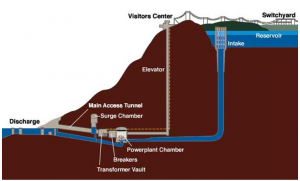Basic Technology Characteristics

Cross section of a pumped hydroelectricity station. Image Courtesy of Voith Hydro.
|
| How it Works:
|
Gravitational potential energy ↔ kinetic energy ↔ electricity
Water is pumped up hill with excess electrical energy which is stored as gravitational potential energy. When energy is needed, water flows down through the generator to produce electricity.
|
| Benefits:
|
- Ability to integrate inverter-based renewables
- Mature, flexible, bulk storage
|
| Challenges:
|
- Capital intensive
- Geographical limits
- Permitting (open-loop)
|
| Technology Variations:
|
|
| Applications:
|
Bulk, long-duration services, power regulation and load following
|
| AC RTE Efficiency:
|
70-85%
|
| Cycle Life:
|
60-100 years1
|
| Technology Readiness Level (TRL):
|
9 - Fully Mature
|
| Installed Capacity:
|
>160 GW
|
